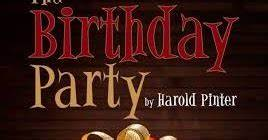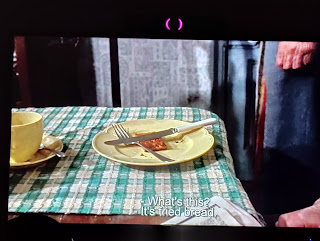‘The Birthday Party’ -Thinking Activity
Thinking activity :
Write a blog on pre-viewing, while-viewing, and post-viewing questions and observations for the movie screening of 'The Birthday Party' mentioned in this blog.
Film Screening:
‘The Birthday Party’ -Thinking Activity
Pre-Viewing Tasks:
· Harold Pinter – the man and his works (Pinter, The Birthday Party)
· Comedy of Menace: Whose plays are known so? Who termed it? What are its peculiar characteristics? How is it different from Absurd Theatre?
· Explain ‘Pinteresque’ – Pinter pause and use of ‘Silence’ in the play: a particular atmosphere and environment in drama.
Deep Dive into Pinter and the Comedy of Menace
Harold Pinter – The Man and His Works
Harold Pinter (1930-2008) was a renowned British playwright, director, screenwriter, and actor. Renowned for his innovative style and exploration of power dynamics, memory, and communication breakdowns, he received the Nobel Prize in Literature in 2005.
"The Birthday Party" is one of Pinter's most celebrated plays, exemplifying the genre of Comedy of Menace. It follows Stanley, a man living a routine life, whose world is disrupted by the arrival of two mysterious strangers. The play uses humor and suspense to create a sense of unease and ambiguity.
'Pinteresque': A Signature Style
The term "Pinteresque" has entered the theatrical lexicon, describing the unique atmosphere and environment Pinter creates in his plays. Here are some key elements:
The Pinter Pause:
These are deliberate silences used to build tension, highlight unspoken emotions, and expose the power struggles within relationships.
Use of Silence:
Silence in Pinter's plays isn't just an absence of sound, it's a potent tool used to communicate unspoken threats, anxieties, and complexities that words fail to express.
Power Dynamics:
Pinter's characters often engage in power struggles, with dominance, control, and manipulation subtly woven into their interactions.
Threats and Ambiguity:
The nature of threats in Pinter's plays is often vague, leaving the audience to grapple with their interpretation and the characters' motives.
Domestic Settings:
Ordinary domestic settings like living rooms become battlegrounds for the power struggles and underlying anxieties in his plays.
Comedy of Menace: A Recap
As a reminder, Comedy of Menace is a genre characterized by:
Humor alongside suspense and threat
Vague threats and uneasy atmosphere
Power struggles and unsettling characters
Humor used as a defense mechanism
Simple settings amplifying the threat
Sparse and repetitive dialogue creating tension
Key Difference from Absurd Theatre:
While both Comedy of Menace and Absurd Theatre utilize humor, their focus and overall atmosphere differ. Comedy of Menace builds suspense with humor in unsettling situations.
Absurd Theatre emphasizes the meaninglessness of existence using illogical humor and situations.
Pinter's masterful use of "Pinteresque" elements and his exploration of power dynamics, anxieties, and communication breakdowns within the framework of Comedy of Menace solidified his place as a theatrical innovator.
How many times does the 'knocking at the door' occur in the play, and does it create a menacing effect in the movie?
In the play "The Birthday Party" by Harold Pinter, the 'knocking at the door' happens multiple times, emphasizing an intrusion of the outside world into the isolated setting of the boarding house. However, in the film adaptation, the frequency of the knocking may vary depending on the director's interpretation. The knocking typically creates a sense of menace in both the play and the film, serving as a motif of looming threat and disruption.
How are 'silences' and 'pauses' utilized in the movie to convey lurking danger and contribute to the comedy of menace?
In the film adaptation, the strategic use of silences and pauses mirrors Pinter's theatrical technique, creating tension and uncertainty. These moments of quietude heighten the audience's awareness of underlying menace, as characters navigate through awkward and ambiguous interactions. The juxtaposition of silence with seemingly mundane dialogue amplifies the sense of impending danger, contributing to the dark humor characteristic of Pinter's style.
What symbolic interpretations can be assigned to objects such as the mirror, toy drum, newspapers, breakfast, chairs, and window-hatch in the movie?
The mirror may symbolize reflection and self-awareness, revealing hidden truths about the characters.
The toy drum could represent childhood innocence juxtaposed with the sinister undertones of the narrative. Newspapers might symbolize the outside world's intrusion into the confined space of the boarding house.
Breakfast and chairs could signify domestic routine and stability disrupted by external forces.
The window-hatch may represent a barrier between the safety of indoors and the unknown dangers outside.
How effectively are scenes like the 'Interrogation scene' (Act 1), 'Birthday Party scene' (Act 2), and 'Faltering Goldberg & Petey’s timid resistance scene' (Act 3) captured in the movie?
The 'Interrogation scene' is effectively captured in the film, portraying the psychological tension between characters as their motivations and allegiances are questioned.
The 'Birthday Party scene' conveys a sense of surrealism and unease, highlighting the absurdity of the characters' interactions amidst the celebration.
The 'Faltering Goldberg & Petey’s timid resistance scene' effectively portrays the power dynamics at play, as characters grapple with manipulation and coercion while maintaining a facade of civility.
Overall, these pivotal scenes contribute to the film's nuanced exploration of Pinter's themes of alienation and existential dread.
Post-Viewing Tasks:
Why are two scenes of Lulu omitted from the movie?
The omission of two scenes involving Lulu from the movie could be a directorial decision to streamline the narrative or to focus more closely on the central themes and characters of the story. These scenes might have been considered less essential to the overall plot or tone of the film adaptation.
Is the movie successful in giving us the effect of menace? Were you able to feel it while reading the text?
Yes, the movie effectively conveys a sense of menace, utilizing various cinematic techniques such as lighting, sound design, and cinematography to evoke tension and unease. While reading the text, the menace is primarily conveyed through Pinter's masterful dialogue and stage directions, which create an atmosphere of suspense and impending threat.
Do you feel the effect of lurking danger while viewing the movie? Were you able to feel the same while reading the text?
Certainly, the movie effectively instills a sense of lurking danger through its visual and auditory elements, as well as the performances of the actors. Similarly, while reading the text, Pinter's skillful use of pauses, silences, and suggestive dialogue creates an atmosphere of uncertainty and apprehension, evoking the feeling of lurking danger.
What do you read in the 'newspaper' in the movie?
In the movie, the content of the newspaper read by Petey to Meg serves as a symbol of the outside world's influence intruding into the sheltered environment of the boarding house. The tearing of the newspaper by McCain and its subsequent concealment by Petey in the final scene may suggest the disruption and suppression of external information or truth.
What interpretations can you give to the positioning of the camera during Blind Man's Buff scenes?
The positioning of the camera over McCain's head during Blind Man's Buff may symbolize his dominance or control over the situation, while the overhead view of the room during Stanley's turn could represent his vulnerability or entrapment within the confines of the boarding house. These camera angles may emphasize the power dynamics at play and the characters' respective roles within the narrative.
Does the movie reflect Pinter's statement about theater's basic elements?
Yes, the movie aligns with Pinter's assertion by creating an enclosed space filled with unpredictable dialogue, where characters are at the mercy of one another and pretense crumbles. The film effectively captures the essence of Pinter's theatrical style, maintaining the tension and ambiguity inherent in his work.
How does viewing the movie help in better understanding the play 'The Birthday Party' with its typical characteristics?
Viewing the movie provides a visual and auditory dimension to Pinter's text, enhancing the audience's comprehension of its typical characteristics such as its painterly imagery, strategic use of pauses and silences, and themes of menace and lurking danger. The film adaptation allows viewers to experience these elements in a new context, deepening their understanding of the play's nuances.
With which of the following observations do you agree?"It's impossible to imagine a better film of Pinter's play than this sensitive, disturbing version directed by William Friedkin" [3]. (Ebert)
If you were the director or screenplay writer, what sort of difference would you make in the making of the movie?As a director or screenwriter, I might explore different interpretations of certain characters or scenes, perhaps emphasizing certain themes or subtexts more prominently. Additionally, I might experiment with the visual and auditory elements to further enhance the atmosphere of menace and uncertainty.
Who would be your choice of actors to play the role of characters?[Provide your choices based on your interpretation of the characters and their traits.]
Here's my casting choice for the characters in "The Birthday Party" based on their traits and the "Comedy of Menace" atmosphere:
Stanley Webber: Daniel Craig - Stanley needs an actor who can portray a sense of underlying vulnerability and confusion while also hinting at a potential hidden side. Craig's ability to balance vulnerability and intensity makes him a good fit.
Meg Boles: Olivia Colman - Meg is a character caught between her affection for Stanley and the pressure from the mysterious men. Colman's ability to play warmth and desperation simultaneously would be perfect for this role.
Petey Boles: Brendan Gleeson - Petey is a gruff but ultimately caring character. Gleeson can bring a gruff exterior with a hint of hidden sensitivity to the role.
Goldberg: Willem Dafoe - Goldberg is a menacing and unpredictable character. Dafoe's piercing eyes and ability to project a sense of hidden threat would make him a chilling Goldberg.
McCann: Tom Hardy - Similar to Goldberg, McCann is another menacing figure. Hardy's physicality and intensity would complement Dafoe's portrayal of Goldberg.
Lulu: Florence Pugh - Lulu is a character with a playful yet unsettling aura. Pugh's ability to balance innocence and something more complex would be intriguing for this role.
Reasoning: These actors all have experience playing characters with complex inner lives and hidden depths, which is essential for the "Pinteresque" atmosphere.
They can all deliver the mix of humor and menace that defines the genre of Comedy of Menace.
The combination of established and up-and-coming actors creates a dynamic and interesting cast.
It's important to remember that this is just a suggestion, and other actors could also be excellent choices for these roles.
Yes, there are similarities among these characters in terms of their experiences of oppression, surveillance, and psychological manipulation within oppressive systems.
Each character grapples with themes of existential dread, powerlessness, and the erosion of personal autonomy in the face of authoritarian regimes or societal structures.
words : 1797
Images : 3





Comments
Post a Comment